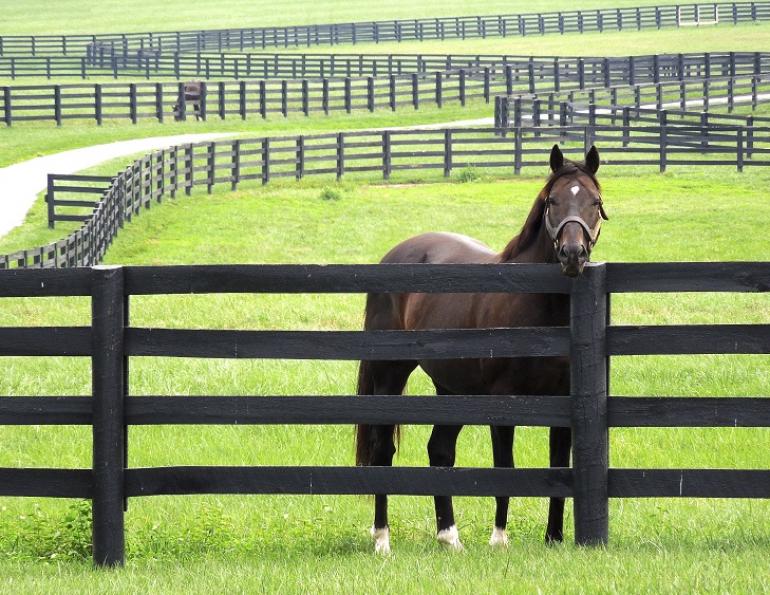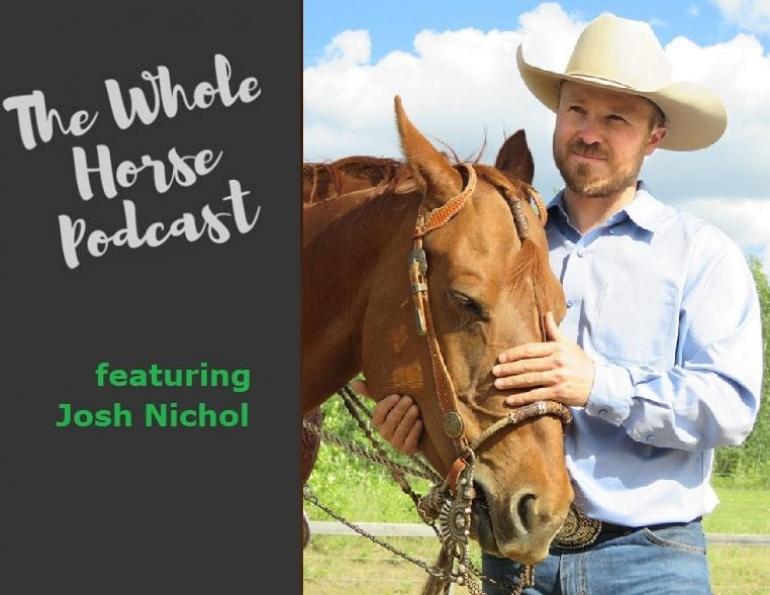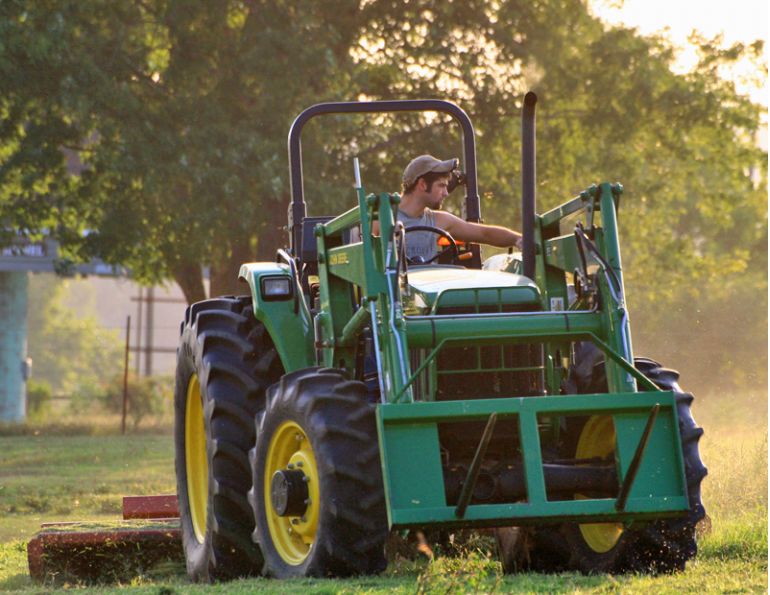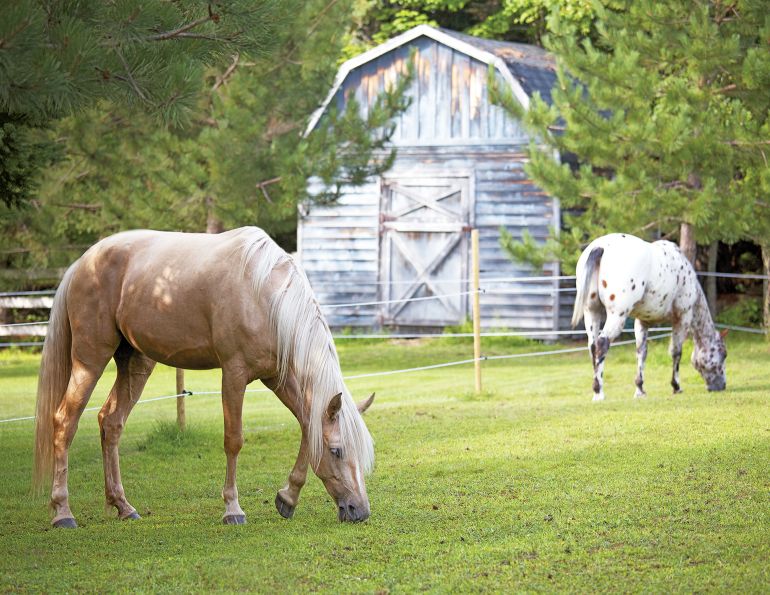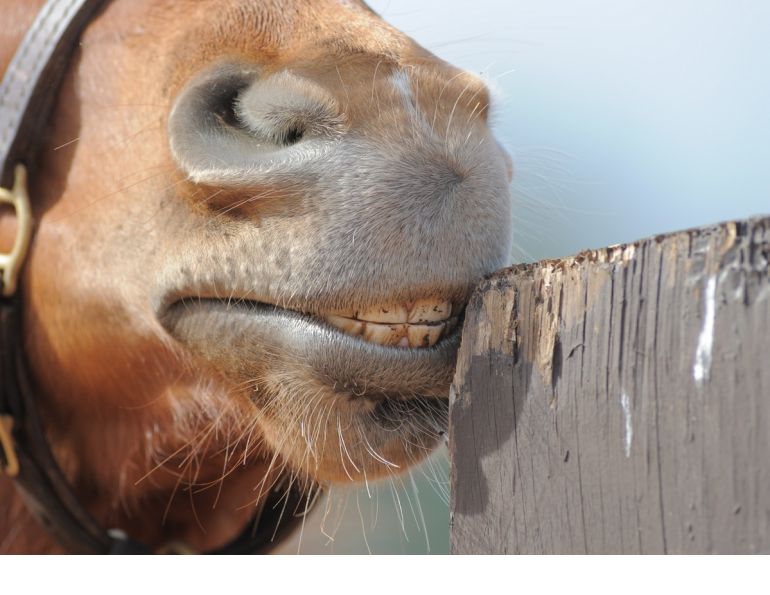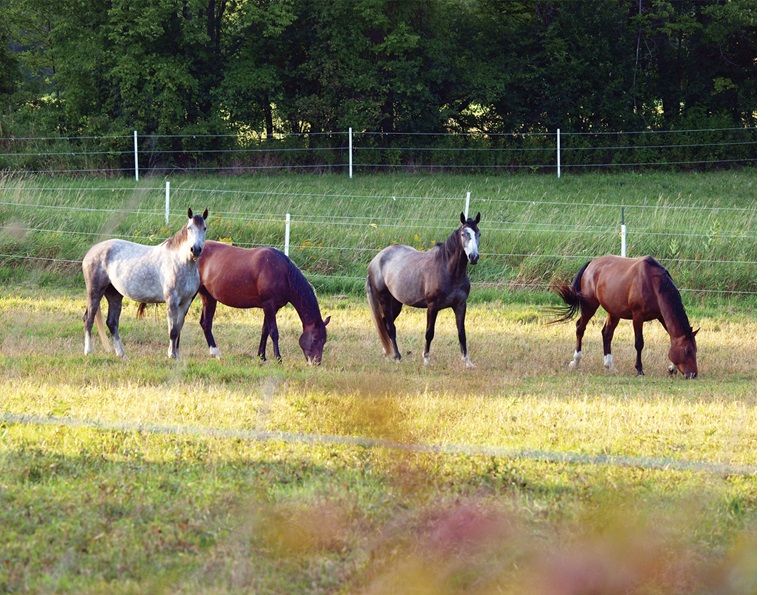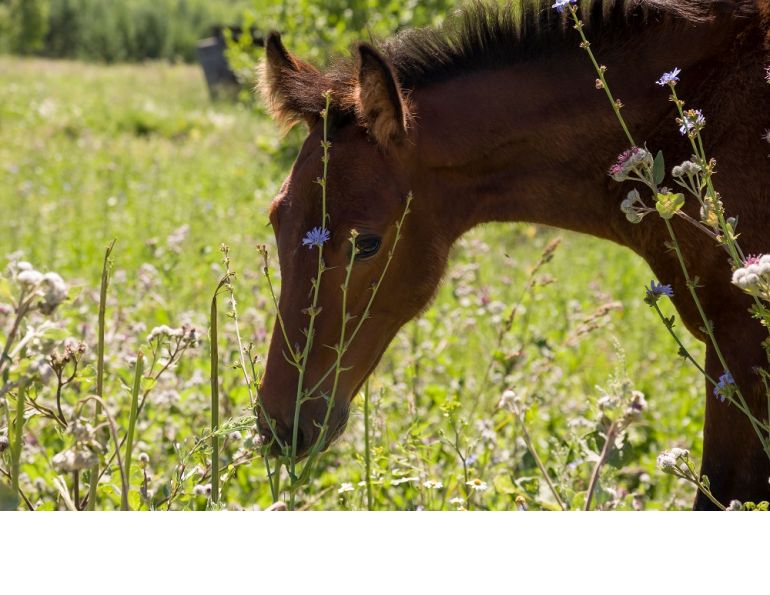By Eileen E. Fabian (Wheeler)
Our fence planning article Plan The Best Horse Fence For Your Property provided information on good horse fence attributes, as well as considerations for selecting and installing the fence, posts, and gates. This article will look at fencing for special areas and needs, provide sample fence planning layouts for public and private stables, and answer some common fencing questions.
Special Fencing Needs
Crowded Areas
Strong, safe fencing should be used where many horses congregate or crowd each other, such as near gates, feed/water stations, or shelters. In areas where horses are not often in contact with the fence, such as in very large pastures, a less substantial fence can suffice. Stronger fencing is needed when there are attractions on the other side, such as better grass or equine companions.
Controlled Grazing
Controlled or rotational grazing of pasture grasses demands that some areas periodically remain without grazing for regrowth of the grass. If temporary or cross fencing is used to designate controlled sections, it should be just as safe for the horses as the permanent perimeter fence. Temporary fence does not have to be quite as impenetrable because the perimeter fence will eventually contain a loose horse (Figure 1). A younger or inexperienced horse will need to be introduced to electric fence used in a controlled grazing system.
All-Weather Paddock
A good management tool for horse facilities on limited acreage is to provide at least one all-weather paddock for foul weather turnout. Also known as a rainy day or sacrifice paddock, this paddock takes the worst wear during unfavourable weather conditions while attempting to preserve the grass of the remaining paddocks. Because turf is easily destroyed during wet conditions, the unfortunate paddock will not be expected to maintain grass and should have all-weather footing. It is to be used for those horses that have to be turned out of their stalls despite the weather.

The sacrifice paddock should be used as an all-weather exercise paddock to preserve the grass of remaining paddocks. It should be located on well-drained high ground and have safe, sturdy fencing. Photo: ©Canstockphoto/Blankartist
This paddock should have safe, sturdy fencing and should be located on well-drained high ground accessible to the stable. Since it will be an ungrassed exercise lot, it is beneficial to locate or screen it away from the more public areas of the stable. Horse contact with the paddock fence is more likely since it is smaller and horses are more likely to be running and playing in it.
Perimeter Fence
Many farms make sure that any loose horse cannot leave the property through the use of perimeter fencing around the entire complex. This fence (and/or gates) fills the gaps at the end of access lanes and often surrounds the public entry side of the facility. Containment of loose horses becomes more important as traffic and neighbours increase around the horse facility. Sometimes the perimeter fence functions to keep human and canine intruders away from the horses.
Perimeter fence does not have to be of the same construction as paddock or pasture fence since it should have limited contact with unsupervised horses, but it should be visible and strong.
Double Fence
An alternate fencing scheme favoured by some farms is to double fence so that each paddock has its own fence with an alley between. Double fencing is almost always used with stallions and particularly valuable stock. Other applications include boarding or training facilities where horses are worked and stabled individually so they are not allowed to socialize. Social and antisocial activity over the fence may be virtually eliminated with double fencing.
A combination double fence and perimeter fence may be used where human contact with horses is discouraged, such as along public roads and residential boundary lines. The first fence keeps the horse in, and the second fence keeps unwanted visitors away from direct horse contact.
Terrain
Some sections of the site may be too steep or rocky for pasture use, or the soil may be unsuitable for adequate grass growth. Soils that do not drain readily will cause wet areas that become eyesores. Horses should be fenced out of unsuitable sites, including swampy areas and streams.
Trees
Trees should be fenced off. Horses usually strip off tree bark left within their reach, and dead branches pose a safety hazard. Some trees are poisonous to horses, while dead limbs can impale them.
Related: Safe and Functional Horse Fencing
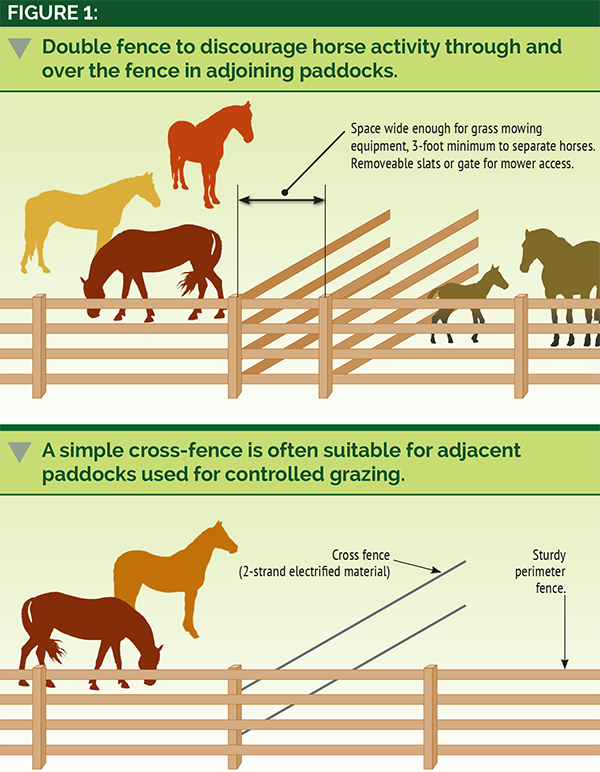
Common Fencing Questions
How much area needs to be enclosed?
Horses may be kept inside most of the time and only turned out for exercise a few hours daily. In some cases, horses are turned out individually rather than in groups. This means more and perhaps smaller paddocks are required which increases the amount of fencing. An all-weather paddock may serve to exercise several horses, in succession, each day. Moving horses between turnout and stable should be convenient.
Rectangular areas are more relaxing for a group of horses but require more fencing than square areas. For example, 800 feet of fencing is needed for a 200-foot square area, versus 1,000 feet of fencing needed for a 400-foot by 100-foot enclosure of the same area. Straight fences on level ground are faster to build and easier to maintain than fencing covering rough terrain.
Plan an average of two to three acres per horse for grazing without supplemental feed during the grass-growing season. Most horses are provided supplemental feed and do not depend entirely on pasture grazing, so acreage per horse becomes less relevant. Acreage needed then depends on the size of turnout paddocks for exercise, and space for riding areas and stables.
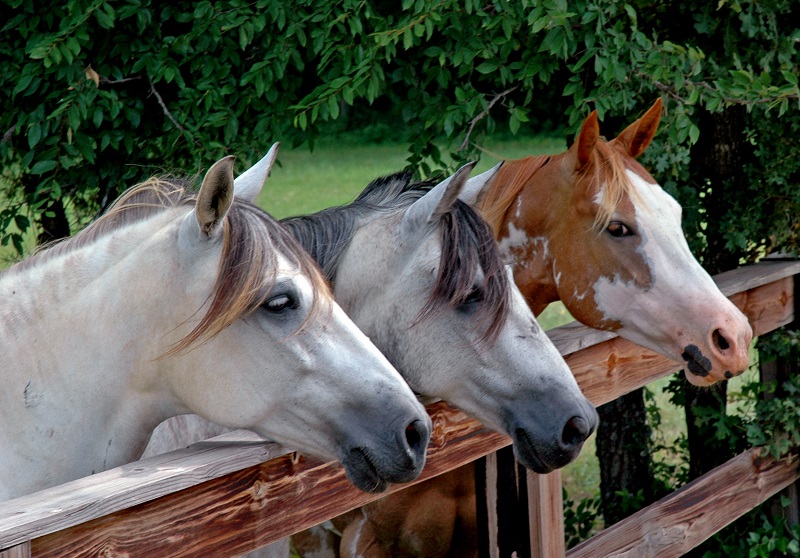
Photo: ©Canstockphoto/Jeff Clow
In overstocked and overgrazed pastures, topsoil erodes as the vegetation is trampled away. Additionally, horse manure is easily transported into nearby areas via water run-off. It is important to contain this run-off so that it does not cause pollution. If topography permits, vegetated areas around the perimeter of ungrassed paddocks may be enough to filter and absorb run-off. Substantial grading of the site will be needed to divert, and possibly store, run-off from large, ungrassed lots. Daily manure removal from the site for storage elsewhere will reduce the concentration of potential pollutants in the run-off.
Why is the horse outside the fence?
Horses are herd animals, usually desiring other equine companions. They can test fence strength in an attempt to join neighbours, especially when a horse is kept alone. Other social pressures and overstocking instill a similar desire to get to the other side of the fence. If the grass really is greener on the other side, expect horse attempts to get to it. Strong, solid-looking fences usually provide adequate protection. Make sure the horse cannot climb the fence, and that social and antisocial activity over the fence will not lead to injuries. Preventing this activity is recommended, but most fences will suffer damage from even innocent horse pastimes such as scratching, chewing, pawing, and playing. Loose wires or boards make it easier for a horse to escape. Maintenance should be factored into the total cost of a fence installation. When electric fencing is chosen, make sure that horses are safely contained during times when the current is off.
How much is reasonable to spend on fencing?
Attractive fences tend to be more expensive. In general, safer fencing is also higher in cost. Some types of fence have a higher initial cost but significantly less maintenance cost and a long lifetime. Some savings are gained by placing the aesthetically pleasing fencing along the public side of the property while less attractive, yet equally functional, fencing can be used in more remote locations.
Save costs by installing the fence yourself, buying fence materials in large lot sizes, or shopping for reasonably priced and locally available materials. Availability and prices for materials vary widely. Keep in mind that some types of fencing are difficult to install properly without specialized equipment, such as wire stretchers and post drivers. Books and fence material manufacturers’ literature are available to explain details of construction.
New fencing materials are appearing on the market every year. Price and warranty vary among manufacturers and installers. Shop around to learn the benefits and drawbacks of different types of fencing. Ask for references from both fence dealers and installers to determine whom to contact for future fence problems. Visit farms with different types of fencing, and talk with the manager about impressions and concerns. A well-designed and carefully selected fence will increase the amount of time you spend with your horses instead of time spent mending the horse and the fence.
Related: TLC for Horse Barns & Properties
Fence Layout Examples
Start fence layout planning with a scaled drawing of the farm and its current features. Include overall distances and special features that need to be fenced around. An affinity diagram (Figure 2) allows a perspective on what features need to be near other features at the facility. This part of the planning process is not concerned with exactly where fences and gates will be, but emphasizes general areas of use on the site. In Figure 2, note that turnout paddocks are conveniently located near the stable, while larger pastures may be farther away. Include a service area that contains manure storage and other features that are not generally considered attractive. Locate the service area away from public view, if possible, and close to the stable for chore efficiency.
Private and public stables have different fence layout objectives, particularly in relation to vehicle traffic flow and access to the residence. Figures 3 and 4 take the features from Figure 1 and provide a layout appropriate for public and private stable sites, respectively. Both figures show fence line positions and gate locations for convenient access to the stable.

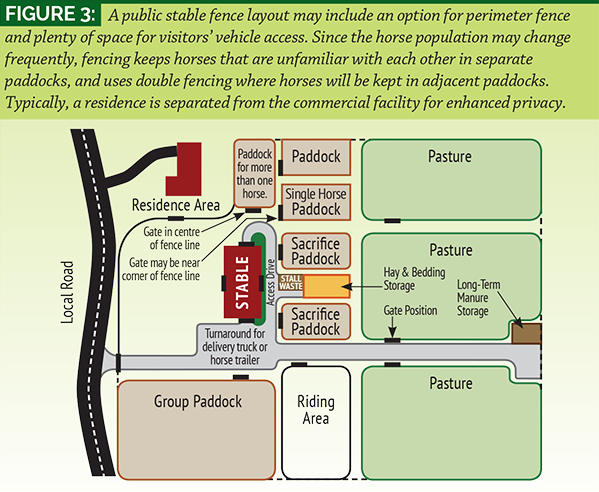
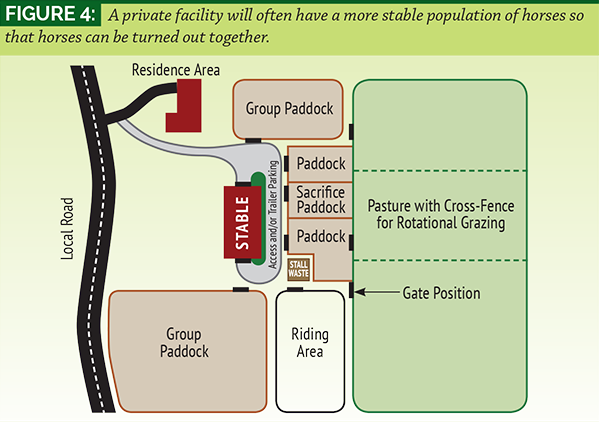
Your property could have several different types of fencing, each serving a different purposes. Good fencing will allow you to control grazing and separate groups of horses based on their respective needs. It should increase your property’s value and visual appeal. And it should enable easy movement and management of horses, removal of manure, and access and movement of equipment. It all starts with good planning and a thorough understanding your facility’s needs.
Related: Plan The Best Horse Fence For Your Property
This article is reprinted with kind permission from Pennsylvania State University.
Photo: ©iStock/GDacey



